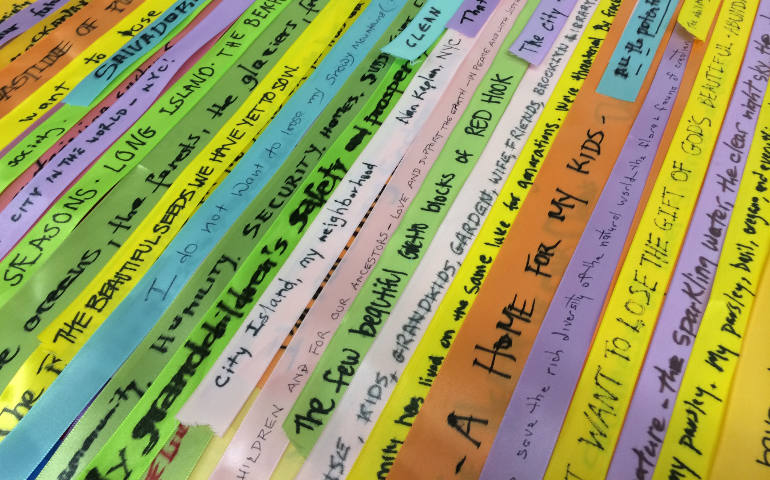
People share on Climate Ribbons what they hope to not lose due to climate change. (TheClimateRibbon.org)
The Climate Ribbon is an interfaith, participatory ritual that uses art and storytelling to grieve what each of us stands to lose to “climate chaos,” while fostering an intimate solidarity that helps us unite to fight against it.
Grounded in ritual traditions from around the world, the Climate Ribbon has a powerful cross-cultural resonance that helps us move through the darkness of the climate crisis toward hope and action while raising up frontline voices and getting them heard in places of power. The ribbon project was begun by Beautiful Trouble and the People’s Climate Arts, with its core team consisting of Kate McNeely, Andrew Boyd, Rae Abileah and Gan Golan.
After its spectacular launch at the People’s Climate March in New York in September, the Climate Ribbon has been inundated with requests from all over the world, including sites all along the path leading up to the next big climate mobilization in Paris, where international negotiators will meet in December.
Related: "When a ritual works: reflections on the People’s Climate March"
The process is simple: In a moment of deep reflection, write on a ribbon what you love and hope to never lose to climate chaos. Share it with others. When you are moved by someone else’s ribbon, tie it to your wrist, committing to work to beat back climate chaos so that our worst fears never come true.
Together, our promises weave a giant tapestry of commitment among all of us for a healthy, sustainable planet.
For Palm Sunday, we plan to use the climate ribbon as a palm. We will join our forebears in marching around town -- probably Washington Square Park and the New York University Law School -- and ask people to join us in a combination of parade and lament.
We were able to use the ribbon with great liturgical success around the climate march. Through it people were able to express a kind of confession, a kind of lament and a kind of absolution.
For Palm Sunday, we want to connect the themes of love and loss to that last day of freedom for Jesus in the city. Part of the power of the parade is that we know it is being noticed by the authorities.
We also know its promise, that liberation, once stated out loud, has a hard time being put back in its cage. We know that power comes when people experience the coincidence of loss and love and tell each other that they did. They find it hard to refuse their own power once they have spoken their truth. To wave the ribbons will be a new kind of palm, one needed in this scary time when even the weather frightens us.
In addition, we plan to install the ribbons already collected and connected to each other -- from the climate march and dozens of other activities -- in our sanctuary for Palm Sunday and Easter. Like the AIDS quilt, the Climate Ribbon will become a traveling symbol, an “ethical spectacle,” like the ark we built for the climate march and the golden calf we built for OCCUPY Wall Street.
There will also be a 108” inflatable globe in our procession. We have come to realize, reluctantly, that these movements need visual symbols. Somehow the issue of the climate is just too large. That initial image of the earth being seen from space is imprinted on our brains; now, we need more pictures.
Why use the big five-dollar words like confession? When you write on a ribbon what you would most hate to lose during climate disruption, sometimes you are aware of your own responsibility for your own loss.
Someone wrote on a ribbon “a babbling brook,” and asked if he should keep driving his car. What was the cost/benefit ratio?
Another said “a loss of confidence in the environment, which results in a loss of confidence in me about me and about us.” That is less a confession than a lament, a sadness spoken out loud to a community from an individual.
In both cases the saying of our losses out loud results in a kind of absolution. It is not complete. It is not just about sin and forgiveness but instead includes them as one of the ribbon’s harmonic themes. When the individual loss is connected to the larger ribbon, people know a slight salvation, a little more security, and a little less fear. Their anxiety receives absolution.
We have created instructions on making your own Climate Ribbon, and if you’re interested in more information or holding a ritual, email us at climateribbon@gmail.com.
Editor's note: Want more stories from Eco Catholic? We can send you an email alert once a week with the latest. Just go to this page and follow directions: Email alert sign-up.


